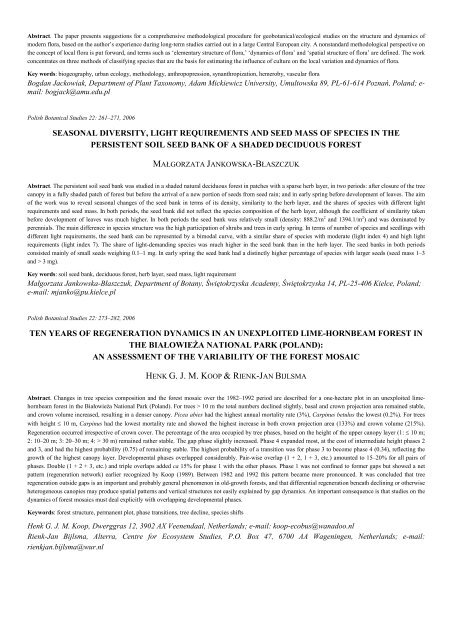Polish Botanical Studies 22 (2006)
Polish Botanical Studies 22 (2006)
Polish Botanical Studies 22 (2006)
You also want an ePaper? Increase the reach of your titles
YUMPU automatically turns print PDFs into web optimized ePapers that Google loves.
Abstract. The paper presents suggestions for a comprehensive methodological procedure for geobotanical/ecological studies on the structure and dynamics of<br />
modern flora, based on the author’s experience during long-term studies carried out in a large Central European city. A nonstandard methodological perspective on<br />
the concept of local flora is put forward, and terms such as ‘elementary structure of flora,’ ‘dynamics of flora’ and ‘spatial structure of flora’ are defined. The work<br />
concentrates on three methods of classifying species that are the basis for estimating the influence of culture on the local variation and dynamics of flora.<br />
Key words: biogeography, urban ecology, methodology, anthropopression, synanthropization, hemeroby, vascular flora<br />
Bogdan Jackowiak, Department of Plant Taxonomy, Adam Mickiewicz University, Umultowska 89, PL-61-614 Poznań, Poland; e-<br />
mail: bogjack@amu.edu.pl<br />
<strong>Polish</strong> <strong>Botanical</strong> <strong>Studies</strong> <strong>22</strong>: 261–271, <strong>2006</strong><br />
SEASONAL DIVERSITY, LIGHT REQUIREMENTS AND SEED MASS OF SPECIES IN THE<br />
PERSISTENT SOIL SEED BANK OF A SHADED DECIDUOUS FOREST<br />
MAŁGORZATA JANKOWSKA-BŁASZCZUK<br />
Abstract. The persistent soil seed bank was studied in a shaded natural deciduous forest in patches with a sparse herb layer, in two periods: after closure of the tree<br />
canopy in a fully shaded patch of forest but before the arrival of a new portion of seeds from seed rain; and in early spring before development of leaves. The aim<br />
of the work was to reveal seasonal changes of the seed bank in terms of its density, similarity to the herb layer, and the shares of species with different light<br />
requirements and seed mass. In both periods, the seed bank did not reflect the species composition of the herb layer, although the coefficient of similarity taken<br />
before development of leaves was much higher. In both periods the seed bank was relatively small (density: 888.2/m 2 and 1394.1/m 2 ) and was dominated by<br />
perennials. The main difference in species structure was the high participation of shrubs and trees in early spring. In terms of number of species and seedlings with<br />
different light requirements, the seed bank can be represented by a bimodal curve, with a similar share of species with moderate (light index 4) and high light<br />
requirements (light index 7). The share of light-demanding species was much higher in the seed bank than in the herb layer. The seed banks in both periods<br />
consisted mainly of small seeds weighing 0.1–1 mg. In early spring the seed bank had a distinctly higher percentage of species with larger seeds (seed mass 1–3<br />
and > 3 mg).<br />
Key words: soil seed bank, deciduous forest, herb layer, seed mass, light requirement<br />
Małgorzata Jankowska-Błaszczuk, Department of Botany, Świętokrzyska Academy, Świętokrzyska 14, PL-25-406 Kielce, Poland;<br />
e-mail: mjanko@pu.kielce.pl<br />
<strong>Polish</strong> <strong>Botanical</strong> <strong>Studies</strong> <strong>22</strong>: 273–282, <strong>2006</strong><br />
TEN YEARS OF REGENERATION DYNAMICS IN AN UNEXPLOITED LIME-HORNBEAM FOREST IN<br />
THE BIAŁOWIEśA NATIONAL PARK (POLAND):<br />
AN ASSESSMENT OF THE VARIABILITY OF THE FOREST MOSAIC<br />
HENK G. J. M. KOOP & RIENK-JAN BIJLSMA<br />
Abstract. Changes in tree species composition and the forest mosaic over the 1982–1992 period are described for a one-hectare plot in an unexploited limehornbeam<br />
forest in the BiałowieŜa National Park (Poland). For trees > 10 m the total numbers declined slightly, basal and crown projection area remained stable,<br />
and crown volume increased, resulting in a denser canopy. Picea abies had the highest annual mortality rate (3%), Carpinus betulus the lowest (0.2%). For trees<br />
with height ≤ 10 m, Carpinus had the lowest mortality rate and showed the highest increase in both crown projection area (133%) and crown volume (215%).<br />
Regeneration occurred irrespective of crown cover. The percentage of the area occupied by tree phases, based on the height of the upper canopy layer (1: ≤ 10 m;<br />
2: 10–20 m; 3: 20–30 m; 4: > 30 m) remained rather stable. The gap phase slightly increased. Phase 4 expanded most, at the cost of intermediate height phases 2<br />
and 3, and had the highest probability (0.75) of remaining stable. The highest probability of a transition was for phase 3 to become phase 4 (0.34), reflecting the<br />
growth of the highest canopy layer. Developmental phases overlapped considerably. Pair-wise overlap (1 + 2, 1 + 3, etc.) amounted to 15–20% for all pairs of<br />
phases. Double (1 + 2 + 3, etc.) and triple overlaps added ca 15% for phase 1 with the other phases. Phase 1 was not confined to former gaps but showed a net<br />
pattern (regeneration network) earlier recognized by Koop (1989). Between 1982 and 1992 this pattern became more pronounced. It was concluded that tree<br />
regeneration outside gaps is an important and probably general phenomenon in old-growth forests, and that differential regeneration beneath declining or otherwise<br />
heterogeneous canopies may produce spatial patterns and vertical structures not easily explained by gap dynamics. An important consequence is that studies on the<br />
dynamics of forest mosaics must deal explicitly with overlapping developmental phases.<br />
Keywords: forest structure, permanent plot, phase transitions, tree decline, species shifts<br />
Henk G. J. M. Koop, Dwerggras 12, 3902 AX Veenendaal, Netherlands; e-mail: koop-ecobus@wanadoo.nl<br />
Rienk-Jan Bijlsma, Alterra, Centre for Ecosystem <strong>Studies</strong>, P.O. Box 47, 6700 AA Wageningen, Netherlands; e-mail:<br />
rienkjan.bijlsma@wur.nl
















